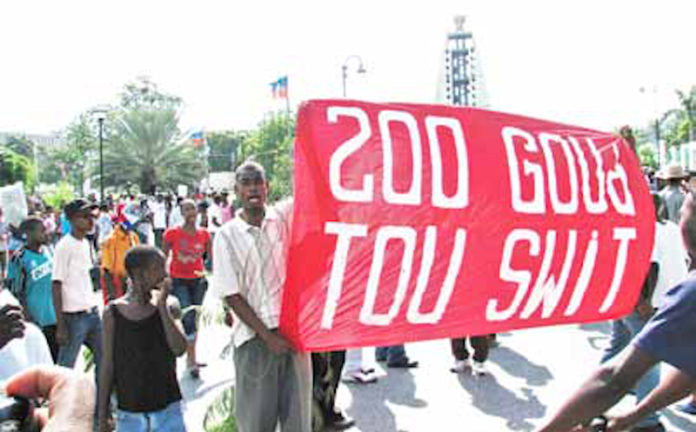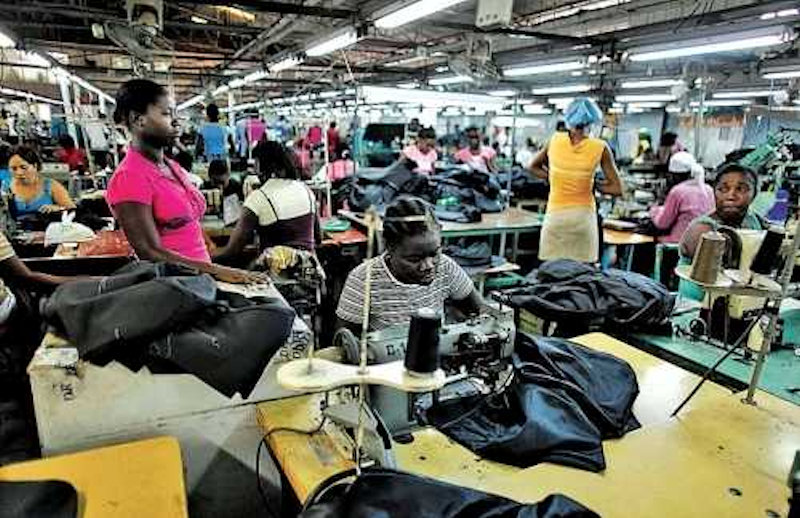
The U.S. Embassy in Haiti worked closely with factory owners contracted by Levi’s, Hanes, and Fruit of the Loom to aggressively block a paltry minimum wage increase for Haitian assembly zone workers, the lowest paid in the hemisphere, according to secret State Department cables.
The factory owners refused to pay 62 cents an hour, or $5 per eight-hour day, as a measure unanimously passed by the Haitian parliament in June 2009 would have mandated. Behind the scenes, the factory owners had the vigorous backing of the U.S. Agency for International Development (USAID) and the U.S. Embassy, show secret U.S. Embassy cables provided to Haïti Liberté by the transparency-advocacy group WikiLeaks.
The minimum daily wage had been 70 gourdes or $1.75 a day.
The factory owners told the Haitian parliament that they were willing to give workers a mere 9 cents an hour pay increase to 31 cents an hour – 100 gourdes daily – to make T-shirts, bras and underwear for U.S. clothing giants like Dockers and Nautica.
between early February 2008 and October 2009, U.S. Embassy officials closely monitored and reported on the minimum wage issue.
To resolve the impasse between the factory owners and parliament, the State Department urged then Haitian President René Préval to intervene.
“A more visible and active engagement by Préval may be critical to resolving the issue of the minimum wage and its protest ‘spin-off’ — or risk the political environment spiraling out of control,” warned U.S. Ambassador Janet Sanderson in a June 10, 2009 cable to Washington.
Two months later, Préval negotiated a deal with Parliament to create a two-tiered minimum wage increase – one for the textile industry at $3.13 (125 gourdes) per day and one for all other industrial and commercial sectors at $5 (200 gourdes) per day.
Still, the U.S. Embassy was not pleased. Deputy Chief of Mission David E. Lindwall said the $5 a day minimum “did not take economic reality into account” but was a populist measure aimed at appealing to “the unemployed and underpaid masses.”
Haitian advocates of the minimum wage argued that it was necessary to keep pace with inflation and alleviate the rising cost of living. As it is, Haiti is the poorest country in the hemisphere and the World Food Program estimates that as many as 3.3 million people in Haiti, a third of the population, are food insecure. Haiti had been rocked by the so-called “clorox” food riots of April 2008, named after hunger so painful that it felt like bleach in your stomach.
According to a 2008 Worker Rights Consortium study, a working class family of one working member and two dependents needed a daily wage of at least 550 Haitian gourdes, or $13.75, to meet normal living expenses.
The revelation of U.S. support for low wages in Haiti’s assembly zones was in a trove of 1,918 cables provided to Haiti Liberté by WikiLeaks.
“As a matter of policy, the Department of State does not comment on documents that purport to contain classified information and strongly condemns any illegal disclosure of such information,” the U.S. Embassy’s Information Officer Jon Piechowski told Haïti Liberté in response to a request for a statement. “In Haiti, approximately 80% of the population is unemployed and 78% earns less than $1/day – the U.S. government is working with the Government of Haiti and international partners to help create jobs, support economic growth, promote foreign direct investment that meets ILO labor standards in the apparel industry, and invest in agriculture and beyond.” (According to the UN, 78% of Haitians live on less than $2, not $1, a day.)

For a 20 month period between early February 2008 and October 2009, U.S. Embassy officials closely monitored and reported on the minimum wage issue. The cables show that the Embassy fully understood the popularity of the measure.
The cables said that the new minimum wage even had support from a majority of the Haitian business community “based on reports that wages in the Dominican Republic and Nicaragua (competitors in the garment industry) will increase also.”
Still, the proposal engendered fierce opposition from Haiti’s tiny assembly zone elite, which Washington had long been supporting with direct financial aid and free trade deals.
In 2006, the U.S. Congress passed the Haitian Hemispheric Opportunity through Partnership Encouragement (HOPE) bill, which gave Haitian assembly zone manufacturers preferential trade incentives. Two years later, Congress passed an even more generous version of the duty-free trade bill called HOPE II, and USAID provided technical assistance and training programs to factories to help them expand and take advantage of the new legislation.
sweatshop owners and Washington won only a partial victory in the minimum wage battle
U.S. Embassy cables claimed that those efforts were imperiled by parliamentary demands for a wage hike to keep pace with soaring inflation and high food prices. “[Textile i]ndustry representatives, led by the Association of Haitian Industry (ADIH), objected to the immediate HTG 130 (USD 3.25) per day wage increase in the assembly sector, saying it would devastate the industry and negatively impact the benefits of the Haitian Hemispheric through Opportunity Partnership Encouragement Act (HOPE II),” said a June 17, 2009, confidential cable from Charge d’Affaires Thomas C. Tighe to Washington.
Ironically, Sanderson’s confidential cable one week earlier, on June 10, noted that the ADIH study had found that “overall, the average salary for workers in the [garment assembly] sector is HTG 173 (USD 4.33),” only 67 cents a day less than the proposed minimum wage. Nonetheless the study urged opposing any rise in the minimum wage because “the current salary structure promotes productivity and serves as a competitive wage in the region.” Sanderson notes, however, in her next sentence that the “minimum salary for workers in the Free Trade Zone on the Haiti-DR border is approximately USD 6.00,” a full dollar more than the 200 gourdes ($5) demanded. Still, the ADIH report concluded somehow “that a minimum daily wage of HTG 200 would result in the loss of 10,000 workers,” more than one third of Haiti’s 27,000 garment workers at that time.
Tighe said that the “ADIH and USAID funded studies on the impact of near tripling of the minimum wage on the textile sector found that an HTG 200 Haitian gourde minimum wage would make the sector economically unviable and consequently force factories to shut down.”
Bolstered by the USAID study, the factory owners lobbied heavily against the increase, meeting President Préval on multiple occasions and more than 40 members of Parliament and political parties, according to the cables.
The Haiti cables also reveal how closely the US Embassy monitored widespread pro-wage increase demonstrations and openly worried about the political impact of the minimum wage battle. UN troops were called in to quell student protests, sparking further demands for the end of the UN military occupation of Haiti.
On Aug. 10, 2009, garment workers, students and other activists demonstrated at the Industrial Park (SONAPI) near the Port-au-Prince airport. The police arrested and carted away two students, Guerchang Bastia and Patrick Joseph, on the charge of inciting the workers. Demanding their immediate release, the protestors marched to the Delmas 33 police station, where the police fired tear-gas and the throng replied with rock-throwing. In the course of the demonstration, the windshield of U.S. Chargé d’Affaires Tighe’s vehicle was smashed, and he took refuge in the police station. Later, when journalists asked him about the incident and the minimum wage controversy, Tighe wouldn’t comment but just said that “it is always a minority which creates disorder.”
Due to the fierce demonstrations of workers and students, sweatshop owners and Washington won only a partial victory in the minimum wage battle, delaying the $5/day minimum for one year and keeping the assembly sector’s minimum wage a notch below all other sectors. In October 2010, assembly workers’ minimum wage increased to 200 gourdes a day, while in all other sectors it went to 250 gourdes ($6.25).
“Every time the minimum wage has been discussed, [the assembly industry bourgeoisie in] ADIH has cried wolf to scare the government against its passage: that raising the minimum wage would mean the certain and immediate closure of industry in Haiti and the cause of a sudden loss of jobs,” wrote the Haitian Platform for Development Alternatives (PAPDA) in a June 2009 press release. “In every case, it was a lie.”











[…] Liberté, using classified diplomatic cables provided to it by Wikileaks, published a searing exposé of how the U.S. Embassy fought a wage hike in Haiti from $1.75 a day to $5 a day, winning $3 a […]